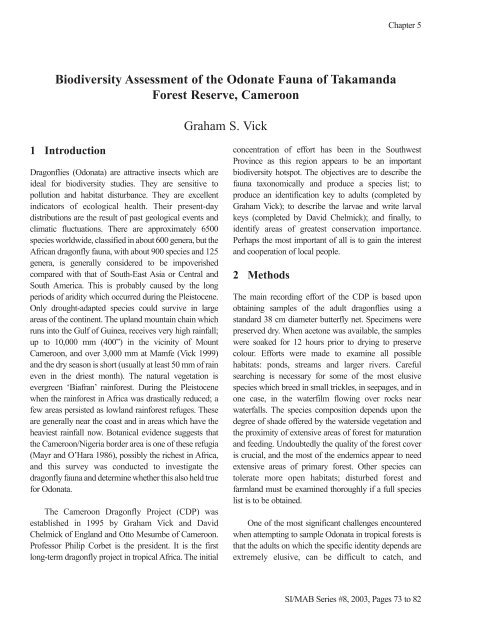Fisheries in the Southern Border Zone of Takamanda - Impact ...
Fisheries in the Southern Border Zone of Takamanda - Impact ...
Fisheries in the Southern Border Zone of Takamanda - Impact ...
You also want an ePaper? Increase the reach of your titles
YUMPU automatically turns print PDFs into web optimized ePapers that Google loves.
Biodiversity Assessment <strong>of</strong> <strong>the</strong> Odonate Fauna <strong>of</strong> <strong>Takamanda</strong><br />
Forest Reserve, Cameroon<br />
1 Introduction<br />
Dragonflies (Odonata) are attractive <strong>in</strong>sects which are<br />
ideal for biodiversity studies. They are sensitive to<br />
pollution and habitat disturbance. They are excellent<br />
<strong>in</strong>dicators <strong>of</strong> ecological health. Their present-day<br />
distributions are <strong>the</strong> result <strong>of</strong> past geological events and<br />
climatic fluctuations. There are approximately 6500<br />
species worldwide, classified <strong>in</strong> about 600 genera, but <strong>the</strong><br />
African dragonfly fauna, with about 900 species and 125<br />
genera, is generally considered to be impoverished<br />
compared with that <strong>of</strong> South-East Asia or Central and<br />
South America. This is probably caused by <strong>the</strong> long<br />
periods <strong>of</strong> aridity which occurred dur<strong>in</strong>g <strong>the</strong> Pleistocene.<br />
Only drought-adapted species could survive <strong>in</strong> large<br />
areas <strong>of</strong> <strong>the</strong> cont<strong>in</strong>ent. The upland mounta<strong>in</strong> cha<strong>in</strong> which<br />
runs <strong>in</strong>to <strong>the</strong> Gulf <strong>of</strong> Gu<strong>in</strong>ea, receives very high ra<strong>in</strong>fall;<br />
up to 10,000 mm (400”) <strong>in</strong> <strong>the</strong> vic<strong>in</strong>ity <strong>of</strong> Mount<br />
Cameroon, and over 3,000 mm at Mamfe (Vick 1999)<br />
and <strong>the</strong> dry season is short (usually at least 50 mm <strong>of</strong> ra<strong>in</strong><br />
even <strong>in</strong> <strong>the</strong> driest month). The natural vegetation is<br />
evergreen ‘Biafran’ ra<strong>in</strong>forest. Dur<strong>in</strong>g <strong>the</strong> Pleistocene<br />
when <strong>the</strong> ra<strong>in</strong>forest <strong>in</strong> Africa was drastically reduced; a<br />
few areas persisted as lowland ra<strong>in</strong>forest refuges. These<br />
are generally near <strong>the</strong> coast and <strong>in</strong> areas which have <strong>the</strong><br />
heaviest ra<strong>in</strong>fall now. Botanical evidence suggests that<br />
<strong>the</strong> Cameroon/Nigeria border area is one <strong>of</strong> <strong>the</strong>se refugia<br />
(Mayr and O’Hara 1986), possibly <strong>the</strong> richest <strong>in</strong> Africa,<br />
and this survey was conducted to <strong>in</strong>vestigate <strong>the</strong><br />
dragonfly fauna and determ<strong>in</strong>e whe<strong>the</strong>r this also held true<br />
for Odonata.<br />
The Cameroon Dragonfly Project (CDP) was<br />
established <strong>in</strong> 1995 by Graham Vick and David<br />
Chelmick <strong>of</strong> England and Otto Mesumbe <strong>of</strong> Cameroon.<br />
Pr<strong>of</strong>essor Philip Corbet is <strong>the</strong> president. It is <strong>the</strong> first<br />
long-term dragonfly project <strong>in</strong> tropical Africa. The <strong>in</strong>itial<br />
Graham S. Vick<br />
concentration <strong>of</strong> effort has been <strong>in</strong> <strong>the</strong> Southwest<br />
Prov<strong>in</strong>ce as this region appears to be an important<br />
biodiversity hotspot. The objectives are to describe <strong>the</strong><br />
fauna taxonomically and produce a species list; to<br />
produce an identification key to adults (completed by<br />
Graham Vick); to describe <strong>the</strong> larvae and write larval<br />
keys (completed by David Chelmick); and f<strong>in</strong>ally, to<br />
identify areas <strong>of</strong> greatest conservation importance.<br />
Perhaps <strong>the</strong> most important <strong>of</strong> all is to ga<strong>in</strong> <strong>the</strong> <strong>in</strong>terest<br />
and cooperation <strong>of</strong> local people.<br />
2 Methods<br />
Chapter 5<br />
The ma<strong>in</strong> record<strong>in</strong>g effort <strong>of</strong> <strong>the</strong> CDP is based upon<br />
obta<strong>in</strong><strong>in</strong>g samples <strong>of</strong> <strong>the</strong> adult dragonflies us<strong>in</strong>g a<br />
standard 38 cm diameter butterfly net. Specimens were<br />
preserved dry. When acetone was available, <strong>the</strong> samples<br />
were soaked for 12 hours prior to dry<strong>in</strong>g to preserve<br />
colour. Efforts were made to exam<strong>in</strong>e all possible<br />
habitats: ponds, streams and larger rivers. Careful<br />
search<strong>in</strong>g is necessary for some <strong>of</strong> <strong>the</strong> most elusive<br />
species which breed <strong>in</strong> small trickles, <strong>in</strong> seepages, and <strong>in</strong><br />
one case, <strong>in</strong> <strong>the</strong> waterfilm flow<strong>in</strong>g over rocks near<br />
waterfalls. The species composition depends upon <strong>the</strong><br />
degree <strong>of</strong> shade <strong>of</strong>fered by <strong>the</strong> waterside vegetation and<br />
<strong>the</strong> proximity <strong>of</strong> extensive areas <strong>of</strong> forest for maturation<br />
and feed<strong>in</strong>g. Undoubtedly <strong>the</strong> quality <strong>of</strong> <strong>the</strong> forest cover<br />
is crucial, and <strong>the</strong> most <strong>of</strong> <strong>the</strong> endemics appear to need<br />
extensive areas <strong>of</strong> primary forest. O<strong>the</strong>r species can<br />
tolerate more open habitats; disturbed forest and<br />
farmland must be exam<strong>in</strong>ed thoroughly if a full species<br />
list is to be obta<strong>in</strong>ed.<br />
One <strong>of</strong> <strong>the</strong> most significant challenges encountered<br />
when attempt<strong>in</strong>g to sample Odonata <strong>in</strong> tropical forests is<br />
that <strong>the</strong> adults on which <strong>the</strong> specific identity depends are<br />
extremely elusive, can be difficult to catch, and<br />
SI/MAB Series #8, 2003, Pages 73 to 82

















